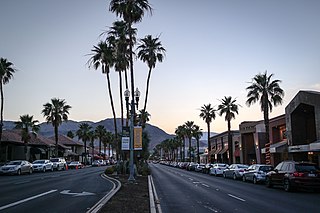
Palm Desert is a city in Riverside County, California, United States, in the Coachella Valley, approximately 14 miles (23 km) east of Palm Springs, 121 miles (195 km) northeast of San Diego and 122 miles (196 km) east of Los Angeles. The population was 48,445 at the 2010 census, up from 41,155 at the 2000 census. The city was one of the state's fastest growing in the 1980s and 1990s, beginning with 11,801 residents in 1980, doubling to 23,650 in 1990, 35,000 in 1995, and nearly double its 1990 population by 2000. A major center of growth in the Coachella Valley, Palm Desert is a popular retreat for "snowbirds" from colder climates, who swell its population by an estimated 31,000 each winter. Palm Desert has seen more residents become "full-timers", mainly from the coasts and urban centers of California, who have come for both affordable and high-valued homes.
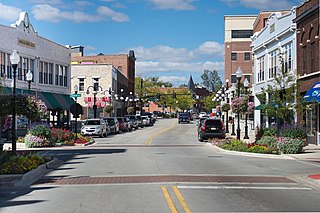
Aurora is a city in the Chicago metropolitan area located partially in DuPage, Kane, Kendall, and Will counties in the U.S. state of Illinois. Located primarily in DuPage and Kane counties, it is the second most populous city in Illinois, after Chicago, and the 124th most populous city in the United States. The population was 197,899 at the 2010 census, and was estimated to be 197,757 in 2019.

Bloomington is a city in and the county seat of McLean County, Illinois, United States. It is adjacent to Normal, and is the more populous of the two principal municipalities of the Bloomington-Normal metropolitan area. Bloomington is 135 miles (217 km) southwest of Chicago, and 162 miles (261 km) northeast of St. Louis. The 2010 Census showed the city had a population of 76,610, making it the 12th most populated city in Illinois, and the fifth-most populous city in the state outside the Chicago Metropolitan Area. Combined with Normal, the twin cities have a population of roughly 130,000. Bloomington is home to State Farm Insurance and Country Financial.

Moody Gardens is an educational tourist destination, with a golf course and hotel in Galveston, Texas which opened in 1986. The non-profit destination uses nature to educate and excite visitors about conservation and wildlife.

Forest Park is a public park in western St. Louis, Missouri. It is a prominent civic center and covers 1,326 acres (5.37 km2). Opened in 1876, more than a decade after its proposal, the park has hosted several significant events, including the Louisiana Purchase Exposition of 1904 and the 1904 Summer Olympics. Bounded by Washington University in St. Louis, Skinker Boulevard, Lindell Boulevard, Kingshighway Boulevard, and Oakland Avenue, it is known as the "Heart of St. Louis" and features a variety of attractions, including the St. Louis Zoo, the St. Louis Art Museum, the Missouri History Museum, and the St. Louis Science Center.
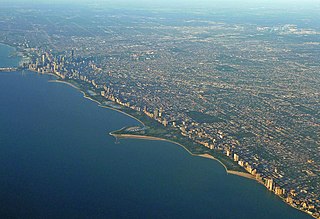
Lincoln Park is a 1,208-acre (489-hectare) park situated along Lake Michigan on the North Side of Chicago, Illinois. Named after US President Abraham Lincoln, it is the city's largest public park and stretches for seven miles (11 km) from Grand Avenue on the south to near Ardmore Avenue on the north, just north of the Lake Shore Drive terminus at Hollywood Avenue. Several museums and a zoo are located between North Avenue and Diversey Parkway in the eponymous neighborhood. Further to the north, the park is characterized by parkland, beaches, recreational areas, nature reserves, and harbors. To the south, there is a more narrow strip of beaches east of Lake Shore Drive, almost to downtown. With 20 million visitors per year, Lincoln Park is the second-most-visited city park in the United States, behind Central Park.

Woodland Park is a 90.9-acre (36.8 ha) public park in Seattle's Phinney Ridge and Green Lake neighborhoods that originated as the estate of Guy C. Phinney, lumber mill owner and real estate developer. Phinney died in 1893, and in 1902, the Olmsted Brothers firm of Boston was hired to design the city's parks, including Woodland Park.

The Como Park Zoo and Marjorie McNeely Conservatory are located in Como Park at 1225 Estabrook Drive, Saint Paul, Minnesota. The park, zoo and conservatory are owned by the City of Saint Paul and are a division of Saint Paul Parks and Recreation. Its attractions include the zoo, the conservatory, an amusement park, a carousel, Lake Como, a golf course, a pool and more. The park receives more than 1.9 million visitors annually. Como Park is a free park and while no admission fee is charged for the zoo or conservatory, voluntary donations of $3 per adult and $2 child are suggested.

Oglebay Park is a self-supporting public municipal park, the only one of its kind, located on the outskirts of Wheeling, West Virginia, on 1,650 acres (670 ha). In 1926, Earl W. Oglebay deeded his estate, Waddington Farms, to the city of Wheeling for the express purpose of public recreation. The park has been open to the public since 1928 when its governing body, the Wheeling Park Commission, began operations.

Hermann Park is a 445-acre (180-hectare) urban park in Houston, Texas, situated at the southern end of the Museum District. The park is located immediately north of the Texas Medical Center and Brays Bayou, east of Rice University, and slightly west of the Third Ward. Hermann Park is home to numerous cultural institutions including the Houston Zoo, Miller Outdoor Theatre, the Houston Museum of Natural Science, and the Hermann Park Golf Course, which became one of the first desegregated public golf courses in the United States in 1954. The park also features the Mary Gibbs and Jesse H. Jones Reflection Pool, numerous gardens, picnic areas, and McGovern Lake, an 8-acre (32,000 m2) recreational lake.

Swope Park is a city park in Kansas City, Missouri. At 1,805 acres (7.30 km2), it is the 51st-largest municipal park in the United States, and the largest park in Kansas City. It is named in honor of Colonel Thomas H. Swope, a philanthropist who donated the land to the city in 1896.
Phillips Park Zoo is located on the grounds of Phillips Park, in Aurora, Illinois, United States. It was originally established in 1915, and is still open year-round with no admission charge. It was once home to exotic animals such as giraffes and monkeys, but the zoo's focus changed to native animals after Brookfield Zoo opened in 1934.

The Jackson Zoo is located in Jackson, Mississippi. The Jackson Zoo was established in 1919 and exhibits over 120 species and approximately 250 individual animals, providing the public the opportunity to observe and study wildlife from around the world and region.
The Dundee Township Park District provides park areas, open spaces, recreational facilities and services. The Park District serves the communities of Carpentersville, East Dundee, West Dundee, Sleepy Hollow, and portions of Elgin, Barrington Hills, Hoffman Estates, Gilberts and Algonquin. The park district is in Kane County, Illinois.
Walter S. Arnold is an American stone carver and sculptor best known for his gargoyles.

Brackenridge Park is a 343-acre public park in San Antonio, Texas, USA, on the city's Broadway Corridor just north of downtown San Antonio.
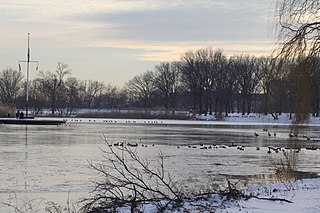
Baisley Pond Park is a public park located in the southeastern part of Queens, New York City, bordering the neighborhoods of South Jamaica, Rochdale, and St. Albans. It covers 109.61 acres (44.36 ha), including the 30-acre (12 ha) Baisley Pond in the center of the park. It is maintained by the New York City Department of Parks and Recreation.
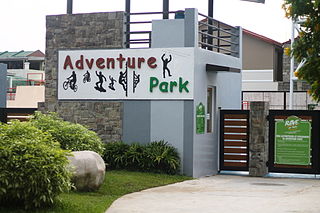
Pasig Rainforest Park, also known as Pasig City Rainforest Adventure Experience and Pasig Central Park, is a public park in Pasig, eastern Metro Manila, Philippines. It spans 8 hectares, and is a mixed recreational and natural park with a mini-zoo. The rainforest park was opened to the public in 1977 with an initial area of 4.8 hectares. It had an Olympic-sized swimming pool, jogging oval, children's playground, tennis courts and a fitness center. In 1996, the park was enlarged with the acquisition of an additional 2.1 hectares. The park was relaunched as the Rainforest Adventure Experience (RAVE) in 2013 with the completion of the boating lagoon, zip line, obstacle course and a skatepark.














